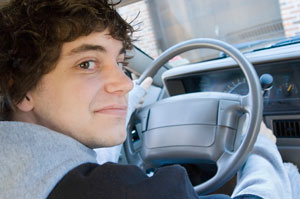

CSYD evaluates a teen driver cell phone restriction
In June, the Insurance Institute for Highway Safety and the Center for the Study of Young Drivers (CSYD) released the results of a first-of-its-kind evaluation of a teen driver cell phone restriction.
The issue of teenagers and distracted driving, particularly related to cell phones, is one of increasing importance. Presently, 20 states and the District of Columbia restrict cell phone use among teenage drivers. North Carolina implemented a cell phone restriction for drivers younger than 18 on December 1, 2006. CSYD researchers used this opportunity to examine the effects of the new law.

"Distracted driving is an issue among all motorists, but the topic of teen drivers and cell phone use, until this point, had not been studied. This was a great opportunity to learn about the effect of a cell phone restriction for teen drivers," said Arthur Goodwin, a researcher with the Center.
The study included observations of several thousand young drivers at high schools as students were dismissed. In addition, telephone surveys were conducted with North Carolina parents and their teens to examine their awareness and opinions of the cell phone law. South Carolina, which does not have a cell phone restriction, was a comparison state for the study. Baseline data was collected in the Fall of 2006, two months before the cell phone restriction took effect. Follow-up data was collected approximately 6 months later.
Results of the study found that teenage drivers' cell phone use was unchanged in North Carolina after the state enacted its cell phone restriction. About 11 percent of teens, both before and after the law, were observed talking on their cell phone while driving. Cell phone use was significantly higher among girls than among boys and when teens were alone in the vehicle rather than with friends. For example, 14 percent of female drivers were observed using cell phones in the pre-law survey, compared with 9 percent of male drivers. Prior to the law, cell phone use was 14 percent among teenagers driving alone compared with 8 percent among those with one or more passengers. Phone use also was higher among SUV drivers compared with those in cars.
"The results show the law didn't have a significant effect on cell phone use among teen drivers, at least in the short term," said Goodwin. "However, it's still possible that compliance with the law will increase as more teens learn about the new law."
In post-law telephone surveys in North Carolina, about 60% of teens were aware of the restriction, compared with only about 40% of parents. Still, 88 percent of parents said they restricted their child's cell phone use while driving. Only 66 percent of teens reported such parental limits. Three-quarters of teens and 95 percent of parents said they approved of the law.
The surveys also indicated that parents and teens alike believe the cell phone restriction isn't being enforced.
"Studies such as these can serve as important tools for researchers and policy makers. What we learn can help us make reforms and adjustments to laws that aim to reduce crashes involving teen drivers," said Goodwin
For a copy of the full text report, visit http://www.iihs.org/research/topics/pdf/r1106.pdf.
The University of North Carolina Highway Safety Research Center
730 Martin Luther King Jr. Blvd, Suite 300 | Campus
Box 3430 | Chapel Hill, NC 27599-3430
Phone: 919.962.2203 | Fax: 919.962.8710
http://www.hsrc.unc.edu